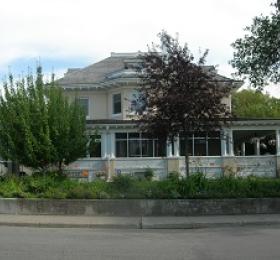Bell House
- Holding Bylaw
Description of the Historic Place
The Bell House is a modified Colonial Revival home that was built in 1910. The stately two and-a-half storey residence is located along the riverbank of the South Saskatchewan River in the neighbourhood of Nutana. Its location was originally chosen for its expansive view of the University of Saskatchewan. The spacious brick building is set on a solid fieldstone foundation and has a covered carriage entrance on its east side.
This historic place, located at 906 Saskatchewan Crescent East, is listed under Bylaw No. 6770 (Holding Bylaw). This Bylaw provides short-term protection of the building from demolition by providing for a 60 day holding period in the event a demolition permit is received. Within that 60 day period heritage designation is considered by City Council.
Heritage Value
The Bell House remains one of the key domestic landmarks of Saskatoon’s boom time period, along with other homes in the area - such as the Calder House and the Hopkins Residence. It is representative of an earlier, opulent age and exhibits Colonial Revival influences, an architectural style that was dominant throughout the first half of the 20th century and commonly featured symmetrical facades, pilasters, decorative entryways and porches. The home was built by former city pioneer and alderman, William J. Bell.
The Bell House was designed by Storey and Van Egmond, Saskatchewan architects credited for also designing the Land Titles Building and Nutana Collegiate. The brick structure exhibits a hipped roof with a full-width, wraparound one-storey verandah. A pillared, covered carriage entrance topped by a triangular pediment is located on the right side of the house. The house features upper and lower decorative cornices and four dormers. Inside, the home featured extensive use of various woods and ceiling beams.
William J. Bell arrived in Saskatoon in 1903, and he would soon make his mark in local business. In 1904-1905 he was a dealer for International Harvester, and later operated Baynes Carriage Company and Reo Automobiles (235 20th Street West) before entering into the field of real estate in the firm of Mighton, Bell and Turner. Bell was elected to Town Council soon after his arrival in Saskatoon and was subsequently appointed to City Council as alderman for Ward Four. Following his retirement from municipal politics in 1907, Bell served on the High School Board and was elected to the University Board of Governors. In this capacity, Bell, along with James Clinkskill, was a key figure in determining the location of the University of Saskatchewan in Saskatoon as opposed to Regina.
The Bell family eventually left Saskatoon for Vancouver in 1928, but the house continued to be the private residence of a number of notable Saskatoon citizens, include James Wilfred Estey (Governor of the University of Saskatchewan before appointment to the Supreme Court of Canada) from 1928 – 1946 and Sidney Buckwold (former Mayor of Saskatoon) in 1948. Despite a number of alterations made to the property over the years, including window changes and enclosure of the northern portion of the verandah, the Bell House has been able to retain much of its earlier grandeur and original character.
Source: City of Saskatoon Built Heritage Database
Character Defining Elements
Key elements which contribute to the heritage value of this historic resource include:
- Those features that relate to its historical and cultural value, including its prominent location adjacent to the South Saskatchewan River, its close proximity to the University of Saskatchewan, and its large scale appearance; and
- Its architecture and Colonial Revival influences, evident in: its symmetrical façade, its brick façade with full width verandah, its hipped roof, dormers, and decorative cornices with dentils, and its pillared covered carriage entrance topped with a triangular pediment.

